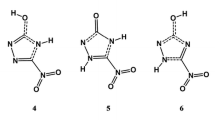Abstract
The present study deals with the evaluation of gas phase proton and methyl cation affinities for alkyl- and nitrosubstituted imidazoles using DFT (B3LYP)/6-31 + G(d) and MP2 methods in the Gaussian 03 software package. The extent of charge delocalization of these cations is correlated with proton affinity. The study reveals that weakly electron-donating alkyl groups at position 1 of the imidazole enhance its proton affinity, which also increases with increasing alkyl chain length. This is expected to result in an increased tendency to form salts. In contrast, the presence of strongly electron-withdrawing nitro groups lowers proton affinity, which decreases as the number of nitro groups on the ring increases. The same trend is observed for the methyl cation affinity, but to a lower degree. These trends in the proton and methyl cation affinities were analyzed to study the effects of these substituents on the basicity of the energetic imidazole moieties and their tendency to form salts. This, in turn, should aid searches for better highly energetic ionic liquids. In addition, calculations performed on different isomers of mono and dinitroimidazoles show that 5-nitro-1H-imidazole and 2,4-dinitro-1H-imidazole are more stable than the other isomers. Amongst the many nitro derivatives of imidazoles considered in the present study, cations resulting from these two would be the best choice for creating highly energetic ionic liquids when coupled with appropriate energetic anions.

Similar content being viewed by others
References
Armstrong JP, Hurst C, Jones RG, Licence P, Lovelock KR, Satterley CJ, Villar-Garcia IJ (2007) Phys Chem Chem Phys 9:982–990
Forsyth SA, Pringle JM, MacFarlane DR (2004) Aust J Chem 57:113–119
Rogers RD, Voth GA (2007) Acc Chem Res 40:1077–1078
Earle MJ, Seddon KR (2000) Pure Appl Chem 72:1391–1398
Johnson KE (2007) Electrochem Soc Interface 16:38–41
Hunt PA (2007) Ionic liquids as fuels and explosives. Hunt Research Group (Imperial College), London (see http://www.ch.ic.ac.uk/hunt/research_il_explosive.html, accessed 20 Sept 2010)
Boatz JA, Gordon MS, Schmidt MW (2005) J Phys Chem A 109:7285–7295
Drake G, Hawkins T, Brand A, Hall L, Mckay M, Vij A, Ismail I (2003) Propellants Explos Pyrotech 28:174–180
Samuelson AG (2000) Resonance. J Sci Educ Res News 5:101–104
Smiglak M, Metlen A, Rogers RD (2007) Acc Chem Res 40:1182–1192
Zorn DD, Boatz JA, Gordon MS (2006) J Phys Chem B 110:11110–11119
Izgorodina EI, Forsyth M, MacFarlane DR (2007) Aust J Chem 60:15–20
Fujii T, Yashiro M, Tokiwa H (1997) J Am Chem Soc 119:12280–12284
Foresman JB, Frisch A (1996) Exploring chemistry with electronic structure methods. Gaussian Inc., Pittsburgh
Liptak MD, Shields GC (2005) Int J Quantum Chem 105:580–587
Nicolaides A, Rauk A, Glukhovtsev MN, Radom L (1996) J Phys Chem 100:17460–17464
Hunter EP, Lias SG (1998) J Phys Chem Ref Data 27:413
Su X, Cheng X, Meng C, Yuan X (2009) J Hazard Mater 161:551–558
Kolaric B, Juranic I, Dumanovic D (2005) J Serb Chem Soc 70:957–968
Grimmett MR (1997) Aromatic substitution approaches to synthesis. In: Imidazole and benzimidzole synthesis, 1st edn. Academic, London, pp 193–194
Gutowski KE, Holbrey JD, Rogers RD, Dixon DA (2005) J Phys Chem B 109:23196–23208
Wei Yin, Narahari Sastry G, Zipse Hendrik (2008) J Am Chem Soc 130:3473–3477
Fox DM, Awad WH, Gilman JW, Maupin PH, De Long HC, Trulove PC (2003) Green Chem 5:724–727
Ogihara W, Yoshizawa M, Ohno H (2004) Chem Lett 33:1022–1023
Acknowledgments
Thanks are due to the University Grants Commission, New Delhi for providing financial assistance to one of the authors (UM).
Author information
Authors and Affiliations
Corresponding author
Rights and permissions
About this article
Cite this article
Singh, H.J., Mukherjee, U. Computational study of proton and methyl cation affinities of imidazole-based highly energetic ionic liquids. J Mol Model 17, 2687–2692 (2011). https://doi.org/10.1007/s00894-011-0955-1
Received:
Accepted:
Published:
Issue Date:
DOI: https://doi.org/10.1007/s00894-011-0955-1



